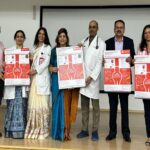Increasing obesity levels in rural India a cause for concern
halthysoch
New Delhi, May 10, 2019 :
Obesity is increasing more rapidly in the world’s rural areas than in cities, according to a study of global trends in body-mass index (BMI). The study, published in the journal Nature, analysed the height and weight data of over 112 million adults across urban and rural areas of 200 countries and territories between 1985 and 2017. The prevalence of obesity in India is increasing and ranges from 8% to 38% in rural and 13% to 50% in urban areas.
Rural areas in low- and middle-income countries have seen shifts towards higher incomes, better infrastructure, more mechanised agriculture and increased car use. These factors not only bring numerous health benefits, but also lead to lower energy expenditure and to more spending on food, which can be processed and low-quality when sufficient regulations are not in place. The need of the hour is large-scale awareness on the importance of healthy eating patterns.
Speaking about this, Padma Shri Awardee, Dr KK Aggarwal, President, HCFI, said, “Obesity is the mother of conditions such as diabetes and heart problems. India faces a dual burden. On the one hand is malnutrition and on the other is obesity. What makes obesity in India different from the rest of the world is that in our country, it is marked by the ‘Thin-Fat Indian Phenotype’. This means that there is a higher proportion of people with body fat, abdominal obesity, and visceral fat, in comparison with Caucasian and European counterparts. Hence, world obesity generally reported in terms of waist circumference, and a BMI beyond 30, significantly underestimates the prevalence of obesity in India. Indian obesity needs to be estimated according to a lower threshold of BMI 25. Additionally, even a normal BMI of up to 23, might show higher instances of isolated abdominal obesity.”
Two primary culprits of obesity include a sedentary lifestyle and unhealthy eating patterns. The consumption of processed food has increased manifold. This, combined with untimely working patterns and lack of physical activity, make the situation worse.
Adding further, Dr Aggarwal said, “The traditional Indian diet is rich in carbohydrates. People consume large quantities of rice, rotis, and even bread. Apart from this, there is widespread availability of fried and unhealthy fast food today, which are all contributors to empty calories in the diet. Indians are caught amidst all this and therefore, the increase in the prevalence of obesity does not come as a surprise.”
Some tips from HCFI
- The key to weight loss is reducing how many calories you take in.
- The concept of energy density can help you satisfy your hunger with fewer calories.
- To make your overall diet healthier, eat more plant-based foods, such as fruits, vegetables and whole-grain carbohydrates.
- Make exercise an important part of your daily routine. Start slow and increase the duration as you go along.
healthysoch







